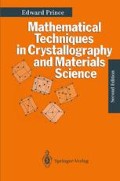Abstract
As we saw in chapter 1, a matrix is an array of numbers that can be used to express a linear relationship between one set of quantities and another. A matrix is thus a very general mathematical concept. If, however, the matrix is used in the physical world to express linear relationships between measurable quantities, such as those between “causes” and “effects”, we are dealing with a restricted type of matrix called a tensor. Suppose, for example, that we apply an electric field, a vector quantity, to a crystal, and measure the electric polarization, another vector quantity. The polarization, P, can be expressed as a function of the field, E, by P = AE. It is obvious that it makes no difference what system of coordinates is used to express the components of P and E, and that the component of P along a direction fixed in space, parallel to a vector, v, for example, is the same in any coordinate system. We can express this statement mathematically by saying that v·P = v·(AE) = vT AE = C, a constant independent of coordinate systems. Or, in other words, the quantity v·(AE) is invariant under all rotations of coordinate axes.
Access this chapter
Tax calculation will be finalised at checkout
Purchases are for personal use only
Preview
Unable to display preview. Download preview PDF.
Author information
Authors and Affiliations
Rights and permissions
Copyright information
© 1994 Springer-Verlag Berlin Heidelberg
About this chapter
Cite this chapter
Prince, E. (1994). Tensors. In: Mathematical Techniques in Crystallography and Materials Science. Springer, Berlin, Heidelberg. https://doi.org/10.1007/978-3-642-97576-9_5
Download citation
DOI: https://doi.org/10.1007/978-3-642-97576-9_5
Publisher Name: Springer, Berlin, Heidelberg
Print ISBN: 978-3-642-97578-3
Online ISBN: 978-3-642-97576-9
eBook Packages: Springer Book Archive

